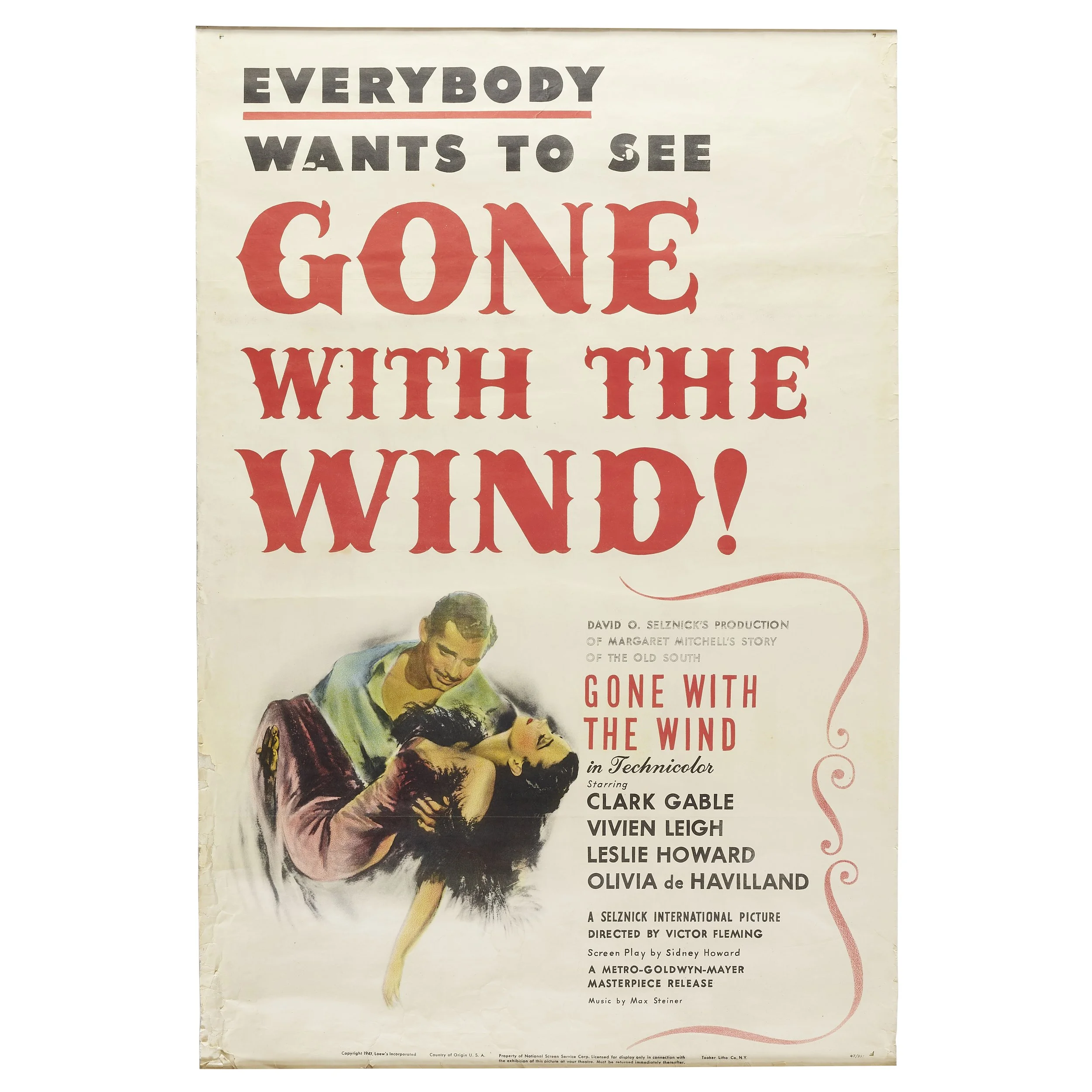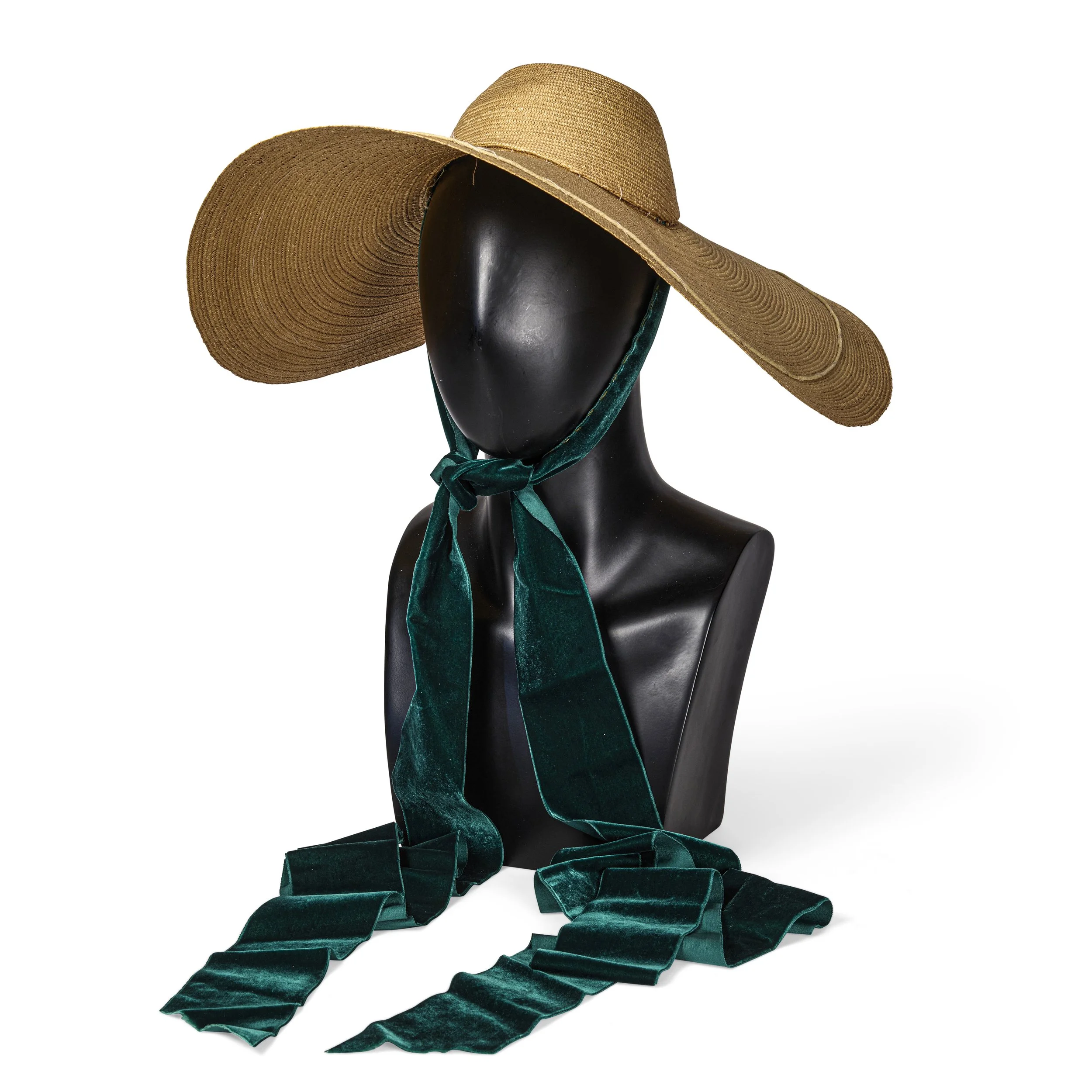Bonhams: Classic Hollywood
by CHAD KENNERK
Bonhams Los Angeles, California's largest auction house, curates sales in multiple collecting categories, including Hollywood Memorabilia. Located on Sunset Boulevard, Bonhams latest sale on the 7th of December includes many items from the collection of Dr. Christopher Sullivan, including the iconic ‘Bengaline’ gown from Gone with the Wind, which Dr. Sullivan wrote about in Film Review earlier this year. For over twenty years, his collection has been on display at the Gone with the Wind Museum in Marietta, Georgia.
“Connie Sutherland has been the museum director for 19 years and we always said that when she retired, I would also call it a day. Well, Connie is retiring at the end of the year. I talked to several auction houses and Bonhams seemed by far the best.”
- Dr. Christopher Sullivan
In addition to Sullivan’s extensive collection, the auction also features a wide range of classic film treasures, such as a rare Citizen Kane correction script and posters from the estate of sci-fi memorabilia collector Wes Shank, who was known as ‘The Caretaker of The Blob’. In advance of the upcoming sale, Film Review chats with Helen Hall, the Director of Popular Culture at Bonhams Los Angeles.
In conversation with Helen Hall, Director of Popular Culture at Bonhams Los Angeles
Film Review (FR): How does a sale like this come together? What’s the process?
Helen Hall
Helen Hall (HH): We were contacted by Chris Sullivan probably about a year ago. First of all, we take a look at everything. We then give auction estimates for the whole collection. We get the fun part of cataloguing and researching everything, finding still photographs. Then everything is photographed at Bonhams in-house. Luckily, Chris is just one of those collectors that’s so passionate, detail oriented, and a completist. Much of the research he already had. From original press clippings to adverts, all of those things help the historical background. It was really great to work with him.
(FR): I’m sure that isn’t always the case. Have there been moments in your career during the research phase where you’ve hit upon on a major success, perhaps finding a press still or behind-the-scenes photo that illustrates a piece or provides provenance?
(HH): A lot of the work that we do is with estates. We often do the appraisal for the IRS and then sell the collection following that. A few years ago, we were called about a known costume collector. He had bought all these costumes over a thirty-year period. They were literally just piled in his guest bedroom, on a pile in the bed. We couldn’t find paperwork. The only things that we could trace were things that he had bought from us. I don’t know how we even started the research, it was mammoth. Someone said, ‘I know he bought a dress from Breakfast at Tiffany’s’ So we started looking through all the gowns and there was no black gown, sadly, but there was this pink cocktail dress. Trawling through stills, we found a publicity photograph of Audrey Hepburn wearing this dress. Then we looked at the film and it appears in this tiny, tiny scene, blink and you’ll miss it. That was such a great one. It was found in a pile of clothes on a bed and ended up making over $150,000. That was a real exciting discovery.
(FR): Is a year a typical timeframe, from when the consignor initially approaches you to sale?
(HH): Not always, we usually need a three month lead time before sales to photograph, catalogue, and produce the catalogue for the sale. It can be anything from three months upwards. I’ve had conversations with clients that have lasted twenty years before they finally decided to sell. It’s an emotional process for people to let go of these things, so sometimes it just depends. Chris was ready to sell and he knew what he wanted, so it’s been a real pleasure to work with him.
(FR): I imagine that’s a great day at work, when you get that kind of call. Especially with a collection like this one.
(HH): A great day. It was really thrilling. I was very excited when I got the call from Chris and discovered the depths of his collection. A lot of people know the collection that was on display in Marietta, but he has a lot of other material too, a lot of more background and academic material, as well as a lot more of the merchandise that was produced in conjunction with the film.
(FR): What was the process like creating the inventory for the collection?
(HH): It was quite a unique situation, because the majority of the pieces were at the museum. That was an easy one from our point of view, to walk through the museum and list everything out. Then when we went back, it was going through the boxes of materials that were not on view.
(FR): What does a typical day look for you, when working on a sale such as this?
(HH): We spend a lot of time writing the catalogue descriptions and getting those right, making sure that we spend a lot of time researching the provenance of pieces. Provenance is very important to us and honestly, if we’re not 100% convinced by where something’s come from or its authenticity, it just doesn’t go into the sale. We spend a lot of time on authenticity and provenance. Again, with Chris’ collection, he had a lot of paperwork. It was great to follow the paper trail of where things had come from and exchanged hands between various owners and collections. Then we spend a lot of time photographing the property. We have a photo studio in-house at Bonhams, so we do the photography and create some wonderful shots. The dress looks so wonderful, that was really fun to setup the shoot for that. Then there’s researching still photographs and making sure things match up. We spend a lot of time making sure that costumes and props really do match up to what’s seen on screen. Every single nuance, every single stitch that you can see.
(FR): How long have you been with Bonhams?
(HH): I’ve only been at Bonhams a year and half actually, but I started out in this field in 1998 at Christie's. I worked for a furniture dealer and I wanted to get into antique furniture. My first job was a temp intern job with Christie's in London. They were doing a James Bond auction. I spent the first week looking at props and costumes, then watching the films and matching them up. I thought, ‘This is the best job ever!’ My dad thought, ‘Is this what we’ve paid for college for? You’re just going to sit and watch movies all day?’ That’s how it started 24 years ago.
(FR): With this particular auction, what pieces excited you the most?
(HH): The dress. It’s just so beautiful. The construction of it is just incredible, the workmanship that’s gone into it. I love the fact that such care is taken with the fabric that was used, and the colour of the fabric, to ensure that it was lit in Technicolor in the best way possible.
(FR): Right, because it’s actually more of a beige, but would have filmed white in Technicolor.
(HH): Yes, exactly, and the panels are actually different colours. The front panels are different colours than the sides. You get this kind of 3D effect, so it wouldn’t look flat on the screen. Also, it’s so tiny! I think I could fit my right leg in it – if one was going to put it on, which one obviously is not. The wonderful thing about it, was that Chris had it mounted on a form by a textile conservator who has worked with some of the best costumes in the film business. It’s on this mannequin and it’s just stunning. I also like a lot of the ephemeral material, tickets from the premiere and things like that. The thing about a ticket is, it was there on the night. It had that kind of presence, that actual experience, which I think is really cool.
(FR): Outside of Chris’ collection, what are some of the other important pieces in this auction?
(HH): We have this pair of display cases from the Biltmore Theatre in LA. I really love them because they’re a real piece of Hollywood and architectural history. You see them outside the theatre from the day it opened in 1924. You see them throughout the years, up until the 1960s, when it was demolished. There are various different shots of archive photography we found of the exterior of the theatre. Different premieres with queues outside and things like that. I think they’re really cool. If I had a home theatre, I would buy those and put them on the wall.
(FR): Are you ever tempted to bid? Is that allowed?
(HH): There are certain checks and measures in place if we wanted to bid on a sale, but honestly, there’s so much I like that it’s just better not to start. There’s some really nice posters in the sale. A lot of really good horror and sci-fi posters that have great artwork. Then some great James Bond posters too. Some of the British posters from the first two films are hugely rare. They’re quite nice to see. We have the quads, but there are also two British double crowns, one for Dr. No and one for Goldfinger. I feel like with Dr. No, I’ve only ever seen one other copy of that. Super rare and one of the first posters ever produced for James Bond movie. We also have a collection from Richard Gladstein, the producer who worked with Quentin Tarantino on many of his movies. He kept a lot of the original movie posters from Pulp Fiction, Reservoir Dogs, things like that. He also has a couple of props from Pulp Fiction, including the Jack Rabbit Slims menu; the restaurant where they do the famous dance scene. They order the food from these menus before and Mia Wallace orders the five dollar milk shake, which John Travolta’s character questions. Then also a couple of scripts, one of which is a really early script. Not many people know that Danny DeVito sought funding for the movie. He was a very early supporter of it and we have this pre-production script that Danny DeVito sent around to try and get financing for it. There’s a label on the front, a Jersey Films label, which was his production company. It says, ‘This script is not to be reproduced or redistributed without authorization from Danny DeVito. To do so will result in unpleasant consequences involving Italians from New Jersey. Thank You. D.D.’
(FR): In the history of your career, have there been pieces that have come out of the woodwork that you’re surprised still exist?
(HH): It’s interesting, because we deal with a lot of estates at Bonhams and because we’re in LA, it’s astounding the things that come up that have been passed down from golden Hollywood era stars through family members over generations. They finally surface when the last in the line passes away or for whatever reason. I’m constantly amazed at the things that do come up. I went to an estate just a few weeks ago, that hopefully will come up in our next sale. An actor from the 1930s. A great name. No one ever knew this stuff was around. The daughter and granddaughter have now passed and, low and behold, it’s around. I worked on the estate of Marlon Brando when I was at another auction house. For him, you go to the house and there’s nothing that would give any sign of his career or what he did for a living. His assistant had kept everything in a bunker in the garden. We opened the doors to this bunker that had been locked up for God knows how many years. As we dug through, we finally got to the back and there were boxes of scripts. The Godfather, Apocalypse Now. Thank God for his assistant, because otherwise he wouldn’t have kept them.
(FR): Do you ever feel like an archeologist? Excavating these pieces from different estates?
(HH): Oh yeah, it’s really fun. It’s like a treasure hunt.
(FR): Has there been one particular treasure that stands out?
(HH): Marlon Brando’s script for The Godfather, that was definitely up there. He had written in the back of it how he was going to play the character, what he would sound like. In handwritten notes, which was just amazing. It made just over $300,00. Not bad for something that hung around in a bunker for 20 years.
(FR): Not bad at all. Will there be a viewing for this sale?
(HH): Yes, we will be on view. We’re previewing selected highlights now, but a really big portion of the Gone with the Wind material will be on view. That will be the 3rd through the 6th of December in our Los Angeles sales room. You can register to bid on Bonhams.com on the sale page or also on each lot. There are many ways to bid. You can watch the sale live and literally just bid on your laptop in real time. You can submit absentee bids in advance of the auction. Or you can just come for good old-fashioned in-person bidding.
HELEN HALL is the Director of Popular Culture at Bonhams in Los Angeles. Ms. Hall has over 20 years of experience in the field of Popular Culture and Entertainment, having worked for Christie's both in London and New York and as an independent appraiser. Throughout the course of her career, Hall has been involved in record-breaking auctions of film, television and music memorabilia including Eric Clapton's guitars, the Estate of Marlon Brando, the Paramount Studios Star Trek Collection, the drum from the cover of the Sgt. Pepper's Lonely Heart Club Band and John Lennon's lyrics for “Give Peace A Chance” to name a few. She also provided the Insurance appraisal for the groundbreaking Victoria and Albert Museum exhibition "David Bowie Is..." Hall is a Certified Member of the Appraisers Association of America and more recently has provided Estate Tax and Donation appraisals for many of the world's most iconic musicians, film stars and television studios.
Learn more about Bonhams and register for the upcoming auction at: https://www.bonhams.com






